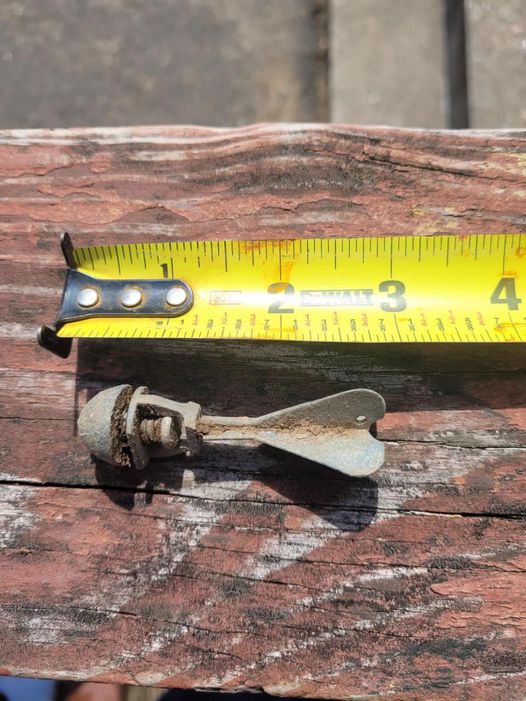In the unassuming landscape of a Northeast USA backyard, a peculiar discovery unfolded. While engaged in routine yard work, a homeowner unearthed a small, metal dart. Its unassuming appearance belied a curious design: a threaded “nose” that tantalizingly resisted complete unscrewing, devoid of any markings or stamps to offer clues about its origin.
Intrigue piqued, the homeowner embarked on a quest to unravel the enigma. Initial speculations ranged from a child’s toy to a forgotten tool, but the absence of identifying characteristics cast doubt on these possibilities. Local experts, including historians and antique dealers, while intrigued, were unable to provide definitive answers.
The digital realm offered a more promising avenue. Online communities, known for their collective knowledge and enthusiasm for the unusual, were presented with high-resolution images of the mysterious dart. A flurry of theories and speculations ensued, painting a vivid picture of the object’s potential identity.
A dominant narrative emerged: the metal dart was once a beloved childhood toy. According to countless online testimonials, it was designed to be paired with small, explosive paper caps. The threaded nose accommodated a spring mechanism, which propelled the cap with force upon impact. A simple yet thrilling pastime, it evoked a wave of nostalgia among those who had experienced the thrill of its explosive performance.
Eyewitness accounts flooded the digital conversation. Users shared vivid memories of their youth, describing the excitement of acquiring a new dart, the meticulous preparation of the paper caps, and the exhilarating moment of the explosive release. The dart, it seemed, was a cornerstone of childhood adventures, a symbol of simpler times.
“Haven’t seen one of these in a while. Likely Kid’s toy – you put a cap in the end, throw it, and it pops on landing,” commented Minimum-Zucchini-732, echoing the sentiments of many.
“It’s an old ‘cap dart/grenade’. Red paper ‘caps’ were inserted in the space, and when thrown would bang on impact,” added prairieson2644, providing further details about the dart’s function.
“Kids toy. You put those paper ‘bangers’ underneath the spring and throw it on a hard surface to make it bang. Same principle as the old pop guns with the paper banger ‘ribbons’,” explained Magicwandza, clarifying the mechanism.
As the online discussion gained momentum, a growing consensus formed around the dart’s identity as a nostalgic childhood toy. However, amidst the nostalgic chorus, a dissenting voice emerged. A few users suggested a more sinister possibility. They proposed that the dart might have been a repurposed component of a more dangerous device. While this theory lacked concrete evidence, it served as a sobering reminder of the potential hazards lurking within seemingly innocuous objects.
“Cap bomb. I must have gone through a hundred of those as a child in the 70’s,” recalled Budget_Roof1065, while aztecforlife warned, “We stuck caps (little explosive wad) in them and they pop when you throw them. Probably removed from the market around the time lawn darts were deemed hazardous.”
The online community continued to share anecdotes and speculations, offering a fascinating glimpse into the past. Some users even described creative ways to enhance the dart’s explosive capabilities, showcasing the ingenuity and resourcefulness of childhood.
“My dad was an engineer and one day he took two bolts with a nut in between and told me to put some caps in the nut and tighten the two bolts down on it. I threw it and it worked. I had dozens of these homemade ones,” boasted bside2234.
Ultimately, the true identity of the metal dart may never be definitively established. Yet, its journey from obscurity to online stardom is a testament to human curiosity and the enduring appeal of the unknown. Whether it was a cherished toy or a relic of a forgotten era, the dart will forever hold a place in the annals of internet folklore.

